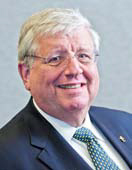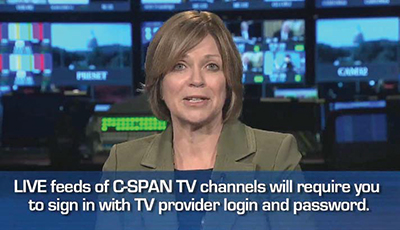C-SPAN Pay Wall Spotlights Multiplatform Challenge

Gary Arlen
C-SPAN’s decision to put its three networks’ core daily telecasts behind an “authentication” pay wall called attention to an increasingly complex challenge: How to familiarize viewers with their multiple options to watch the same programming.
Beyond the restriction of real-time simulcast online streams to paying viewers, C-SPAN is barely modifying its current procedures. Yet, the announcement in late July of changes that will slowly roll into effect this autumn underscored the misperceptions that audiences—even the policy- savvy wonks who tune into C-SPAN’s legislative proceedings—have about the multiplatform migration and program sourcing.
BUSINESS MODEL REVISION
Fundamentally, the only significant change is that C-SPAN will only provide the online simulcasts of the C-SPAN channel (which covers all House of Representatives sessions); C-SPAN2 (which carries Senate sessions); and C-SPAN3 (which programs a potpourri of shows including lectures, academic presentations, book discussions plus reruns of government events) to viewers who subscribe to cable or satellite services.
“If you want to watch the live feeds of our TV channels, you’ll first need to sign in with your cable or satellite company credentials,” said C-SPAN Co-CEO Susan Swain in an online video explanation of the changes. She added that C-SPAN’s business model revision “reflects the dynamic changes you can see going on in video distribution today.”
The viewer authentication policy coincided with C-SPAN’s expansion of its mobile apps, including its C-SPAN radio service.
C-SPAN Vice President of Affiliate Relations Peter Kiley characterizes the new policy as “a hybrid delivery system,” since all of the programs—even those that CSPAN produces itself—will be available via the company’s online video archive, usually about an hour after the original telecast. Original shows such as “The Communicators” and “Washington Journal” will be available on a delayed basis; the streaming quality may be somewhat lower than that which authenticated viewers can see, Kiley said.

C-SPAN Co-CEO Susan Swain explaining the new pay-wall system via video on the network’s website. As pay walls go, the Cable-Satellite Public Affairs Network’s barrier is minimal. To see live online feeds of the three networks, viewers will have to register to confirm that they are paying customers of an affiliated cable or satellite TV, using the cable industry’s TV Everywhere authentication system. Links on the C-SPAN home page direct users to the TV Everywhere process.
C-SPAN managed its announcement of the pay wall aggressively. A fortnight after disclosing the pay wall plan, Kiley told TV Technology that merely a handful of viewers had questioned or complained about the process and that far more viewers had signed up via the authentication service. Although Kiley declined to specify the number of complaints or registrations, he did acknowledge that the summer timing was deliberate, with Congress preparing for a long recess. He said C-SPAN valued the slow political season for the transition. Kiley also suggested that the actual switchover to required authentication may kick in after the short autumn session, but before the election recess.
FREE TO VIEWERS
The streaming video announcement pushed to the surface a variety of issues about how C-SPAN’s content is used. A valuable component of C-SPAN’s 35-year history is its Video Library: nearly 206,000 hours of programs (which continues to grow), including Congressional sessions, hearings and events. About 180,000 videos from that collection have been viewed so far this year, with daily access accounting for more than 10,000 “titles” (video segments, such as individual floor speeches). That library will still be available for free to all viewers, whether or not they are cable customers.
Adding some confusion to the pay wall issue stems from the belief of some viewers that C-SPAN itself is a government video service, rather than its reality: C-SPAN is a private nonprofit organization funded initially by the cable industry, in part, for the “halo effect” it provided during the industry’s contentious growth phase in the 1980s (which had different contentious issues than today’s confrontational environment.)
Beyond the video feed it receives from the two chambers of Congress, C-SPAN produces video for its other programming, including congressional committee and subcommittee sessions, plus sessions from regulatory agencies. For example, C-SPAN carries meetings of the Federal Communications Commission, either live or on a delayed basis, depending on timing.
The House and Senate floor feeds are produced by the respective video units of each congressional chamber. Kiley pointed out that C-SPAN is pursuing its “longstanding request to Congress” that it be allowed to install and operate its own video cameras in each chamber. Congress has repeatedly refused such proposals, he said.
In anticipation of the changes, C-SPAN redesigned its website (www.C-SPAN.org) earlier this year to make access more “platform- agnostic” and “mobile-friendly,” Kiley said. Live streams of all federal government events covered by C-SPAN will continue to be available online via a direct link from the home page, with no sign-in required. The revamped home page highlights “Congress, White House and Courts.”
Separately—and most timely going into a campaign season—C-SPAN’s video archive offers a treasure trove of indexed video clips, especially statements that rival candidates savor in their attack ads about what incumbents have said or promised. The increased online access—authentication notwithstanding—opens opportunities for campaigns to harvest more and newer material to pump into their own video, which is increasingly aimed at online distribution.
C-SPAN has a notoriously liberal policy for makings its videos available, especially for scholarly research. But it does not permit unlicensed commercial use of any of its video programming except for public domain House and Senate floor video. It licenses the original video that it produces for use in documentaries, films or TV programs as well as in trade or business productions.
Restricting its live network feeds to paying customers reflects efforts throughout the TV industry to readjust financial fundamentals for the multiplatform era. Although a handful of policy wonks may wonder about the differences between “real-time online access” and “live streams” (as enunciated in C-SPAN’s fact sheet about its changes), those are merely linguistic nuances in the bigger issue of content monetization— even (or especially) at a nonprofit organization.
Gary Arlen is president of Arlen Communications LLC, a research and consulting firm. He can be reached atwww.ArlenCom.com.
Get the TV Tech Newsletter
The professional video industry's #1 source for news, trends and product and tech information. Sign up below.
Gary Arlen, a contributor to Broadcasting & Cable, NextTV and TV Tech, is known for his visionary insights into the convergence of media + telecom + content + technology. His perspectives on public/tech policy, marketing and audience measurement have added to the value of his research and analyses of emerging interactive and broadband services. Gary was founder/editor/publisher of Interactivity Report, TeleServices Report and other influential newsletters; he was the long-time “curmudgeon” columnist for Multichannel News as well as a regular contributor to AdMap, Washington Technology and Telecommunications Reports; Gary writes regularly about trends and media/marketing for the Consumer Technology Association's i3 magazine plus several blogs.

